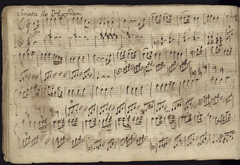18th-Century Music Manuscript "Libro Sesto" Tells of Colonial History in Chile
Thursday, February 25, 2016

The Biblioteca Nacional de Chile in Santiago (RCH-Sbnc) is home to a rare music manuscript from ca. 1790, which it has had in its possession since January 2014. It was a gift from the descendants of the Chilean musicologist Guillermo Marchant Espinoza (1950-2009), who rescued it from the rubble during a house demolition. The manuscript is titled Libro sesto, implying that at least five other similar manuscripts must have existed that have not yet come to light.
As was announced when the book was presented to the library, the Libro Sesto is one of the few documents that bears witness to colonial instrumental music in South America. It contains 165 works for keyboard and/or organ that the African slave Maria Antonia Palacios copied out for her own use, as she was responsible for music at her master’s home and church.
Marchant Espinoza described the manuscript in detail in the Revista musical chilena in 1999. The volume is 186 pages (98 folios) and measures 28.6 x 20.2 cm.
Of the 165 pieces, 72 are anonymous and 93 have composer attributions. The name of Spanish composer Juan Capistrano Coley y Embid appears the most often, on 29 pieces; he applied for the post of organist in Pamplona in 1787 without success and later appears in Viana, Zaragoza, and the monestery at Valpuesta until 1796. After that, all traces of him disappear. Additional composers are Juan de Lambida, Pedro Perez, Palazin (or Palarin), Procíoli (identified by Espinoza as Giambattista Grazioli, organist in Venice), and Vincente Joachín Castillion, who is listed as professor of organ and organist in Madrid. This seemingly Spanish/Italian repertoire also surprisingly contains compositions by two more northern composers: Joseph Haydn and Ignaz Pleyel. The first movement of Haydn’s piano sonata in C major, Hob.XVI:35, is notated in the manuscript, but this Chilean source is not known in Anthony Hoboken’s thematic catalog. The manuscript also contains six minuets and two marches for the salterio (similar to a dulcimer), which might be arrangements. These works are not in Rita Benton’s Ignace Pleyel: A Thematic Catalogue of his Compositions (New York: Pendragon Press, 1977).
All the same, it is interesting to note how quickly these works traveled from Europe to Chile. According to Hoboken, the Haydn sonata dates from before 1780, so within around 10 years, the piece must have been so widespread that it was even copied down in Santiago.
The manuscript is currently being cataloged for the RISM database (RISM ID no. 390000001). It is possible that some anonymous works will be identified in the course of cataloging. You can view the catalog record for the Libro sesto on the website of the Biblioteca Nacional de Chile.
Below, please enjoy a performance from the ceremony in 2014 at which Maria Antonia Palacios’s important manuscript was donated to the National Library. The Ensamble Alta Voce performs excerpts from the Libro sesto.
Share Tweet Email
Category: In the news

